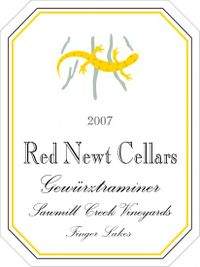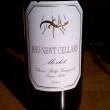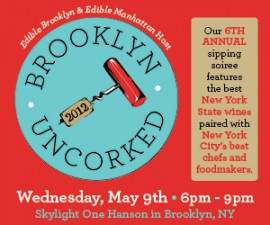Red Newt Cellars 2007 Sawmill Creek Vineyards Gewurztraminer
By Lenn Thompson, Editor and Publisher
 When I heard that Red Newt Wine Cellars was releasing two single-vineyard Gewurztraminers, I was intrigued. Did the two vineyards really warrant separate bottlings, or was it a marketing ploy along the lines of "reserve" labels?
When I heard that Red Newt Wine Cellars was releasing two single-vineyard Gewurztraminers, I was intrigued. Did the two vineyards really warrant separate bottlings, or was it a marketing ploy along the lines of "reserve" labels?
And when I heard they were price at $36 and $42, I'll admit that I even thought to myself "Have they lost their minds?"
Now that I've tasted them, I can say definitively that yes, the two vineyards (in 2007 anyway) led to distinct wines worthy of single-vineyard labeling.
Are the prices exorbitant? That's really up to you, but I can tell you this: these are expressive, distinctive wines that deserve your attention and show what is possible in the Finger Lakes with the 'other' aromatic white grape. You know, the one that isn't riesling.
The nose on this Red Newt Cellars 2007 Sawmill Creek Vineyards Gewurztraminer ($36), made with fruit from Jim Hazlitt's Sawmill Creek Vineyard, is an attractive melange of juicy ripe pears, dried orange peel, kiwi and white flowers with subtle spice and lychee notes in the background.
Elegant, mouthwatering pear and kiwi fruit flavors dominate the medium-bodied palate, with candied ginger, spice and floral notes bringing nuance. This wine's balance, brought about by tongue-tingling acidity, and it's long orange-peel inflected finish are what really helps it stand out.
Check back next week for my review of Red Newt Cellars' 2007 Curry Creek Vineyards Gewurztraminer.
Producer: Red Newt Cellars
AVA: Finger Lakes
Price: $36
Rating:
(4 out of 5 | Delicious, Distinctive
)


















Hey why not? Isnt it all part of learning and defining the appelation, seeing what works, whats good where? It dosent seem like many Long Island wineries do stuff synically as marketing ploys, it seems like most people down there have the best interests of the appelation in mind when they do stuff like this. Its a shame that our wine industry has to grow and develope under the influence of the market. From pre Roman times until Napoleon came, the only influence on the best french wine areas was to create the best wines possible (as opposed to the most profitable).
sounds awesome Lenn. A bit pricey as you mentioned compared to rocking Gewurtz from say Oregon.
also, why is the newt yellow on the label?
I doubt I’ll be buying any at that price - I hope FL wine is not going to be pricing itself out of my life. If I wanted to spend $36 on gewurztraminer I would probably go for Alsace Grand Cru.
Cyclist - That’s dismissively smug of you. How do you know that the RN Gewurz is not on par or better than some Alsace wine? I can promise you that Dave Whiting took pains to find out where his two single-vineyard Gewurzes fit in when it comes to price range and quality.
No one wants to see every wine shoot to $30+, but if a winemaker feels he or she has something special, the market will inform them whether they’ve set the right price. But the basis of your comment indicates that you’re not willing to try a FL Gewurz at that price to begin with, though you are willing to spend that much for other Gewurz.
Dave makes good gewurz, no doubt about that. And Sawmill Creek is a nice site. Several producers buy grapes from there - but why does a bottle of gewurz from that site suddenly fetch $36? It appears that the NY producers have seen what CA and OR have done: slap a vineyard specific label on a bottle and double the price. Nice game, I hope they can sell the stuff during the coming economic collapse.
I’m dismissive because in Alsace the good GC sites have a track record of many decades or centuries for producing the best gewurz (or riesling, pinot gris, etc.). Some of these sites are hard to work, and the actual size is small and delimited, grapes harvested by hand and carefully selected. Then we are paying a premium to have them imported to the US. Yet I can still pick up a nice example for $36 if I’m a careful shopper.
Standing Stone and Lamoreaux (just for example) both are making nice gewurz and keeping the price under $20. They are wines I purchase almost every year.
Cyclist: Have you tasted this wine? If not, I don’t think you’re really in a position to say that it’s overpriced or blindly suggest that you can get a better value from Alsace.
That’s not to say that $36 (or $41, which is what the wine I’ll be reviewing today is) is more money that most of us spend on Gewurzt. Lamoreaux Landing, Standing Stone and Sheldrake Point (among others) do make terrific examples at prices below this, certainly. But, it’s important to remember that the concept of “value” isn’t limited to wines under $20. There are values at every price point.
Your argument about track record, while interesting, is a little shortsighted. Each of those vineyards had years early in their development when they made wines of special quality. Is it possible that Sawmill Creek will become one of these vineyards and this is an early glimpse of that? Maybe.
The “New York wines are overpriced” comment is one that I’ve heard for a long time, mostly related to Long Island wines. I’ve argued that, yes, there are many New York wines that are overpriced (at all price points) but there are also some amazing values (at all price points).
A quick look around the wine world at large will show that the situation is similar almost every where you look. People who are used to buying $10 wines from hot growing regions are more than welcome to keep drinking those wines, but I’d rather drink hand-crafted products of balance and elegance.
What I’m most interested in seeing is if other, perhaps lesser, producers will try to ride the rising tide and attempt to sell their own single-vineyard wines for similar prices. It’s happened on Long Island with merlot and red blends, which has contributed to the incorrect impression that all Long Island reds are poor values.
Just a little while ago I had the chance to taste
both wines. They are the most distinguished and best
Gewuerztraminers I have tasted from the Finger Lakes. There are for sure some very good
Gewuerztraminer out there, but these two wines are a
statement for what we can accomplish up here with this
variety.
I am happy for Dave that he has the courage to
price those wines at this level. Extraordinary wines
deserve extraordinary attention. Dave is an amazing winemaker besides being a very humble man. He knows the best the potential of this vineyard side and the wines resulting out of it. We can’t be ashamed of pricing special wines according to their quality.
I believe we still should and will see the majority of Finger Lakes wines being priced below 20 Dollar, but we are just about to experience the amazing potential for quality up here.
Johannes Reinhardt
Anthony Road Wine Co.
I’d be surprised if any of the people adding comments, including myself , can name an Alsatian Grand Cru wine that they would pay $40 for. (and don’t say Trimbach)
, can name an Alsatian Grand Cru wine that they would pay $40 for. (and don’t say Trimbach)
Apples and oranges.
I want to know if they are pouring these wines in their tasting room and what that fee may be. I can’t see myself spending that money without knowing that my palate finds worthy.
I do think the only way any NY wine will get the respect of west coast or old world wine, is if they make the best possible wine they can. If it comes from a single vineyard and has to be expensive, than so be it.
While I don’t agree with all of cyclist’s assertions, I think it’s important to question relative values. There is a well-known wine region about 3,000 miles west of here that has certainly failed in that respect, and while the situation in NY is hardly comparable I can’t blame anyone for asking why one wine is worth more than another. A consumer should ask these types of questions constantly!
I suspect these are very good wines and I would love to buy them although I’ve never been in a position of spend frivolousy on fermented grape juice. If I decide to pull the trigger, the purchase will follow some consideration, albeit in this case my curiousity will make it a much easier decision. I love gewurtztraminer, I trust Lenn’s judgment, and Red Newt has made some very good bottles of the stuff in the past.
Lenn: I’m not in a place where I can taste this wine but plan to spend some time in the FL in the next month, so I will try to stop by Red Newt for a tasting. Having said this, I have tasted some of the higher priced ‘reserve’ or single vineyard offerings from the FL alongside their ‘ordinary’ counterparts and found the pricing was sometimes very ballsy. On occasion, the reserve bottlings have even been inferior. I might be more inclined to buy them if they were a few dollars more than the lower bottlings, but almost double the price is a barrier. But hey, if there are enough customers who think $ = quality, then they will be happy.
Bryan: I’m not sure what you mean in your comment re. $40 Alsace wines. While you cannot buy GC wines from the likes of Weinbach or Zind-Humbrecht for anywhere close to $40, I’ve had fine bottles of GC gewurz in that price range (or less) from F. Mallo, A. Mann, Schlumberger, Schleret to name a few. And why not mention Trimbach: in a good year, their basic $18 gewurz is usually a solid buy. They have some fine GC vineyards but they don’t bottle these wines under a vineyard name, instead using designations like the great “Seigneurs de Ribeaupierre” The situation is not exactly “apples and oranges”: Alsace gewurz will be the yardsick by which this wine will be measured.
Cyclist,
You maintain your anonymity, so why not offer specific examples of single-vineyard FL wines that are inferior to their “regular” bottlings? I’m not even aware of more than about half a dozen single-vineyard wines to begin with. Heron Hill’s Ingle wines, Red Newt Gewurz and ’07 reds, Ravines Argetsinger and ’07 Merlot, Wiemer, McGregor Seyval. I’m sure there are others — Lakewood, perhaps — but you write about the practice as if it’s widespread.
Cyclist: I’ll be curious to hear what you think after you taste them. Until then, this argument really doesn’t make a whole lot of sense or hold much water (wine?)
I agree that sometimes I prefer the ‘regular’ bottlings to the ‘reserve’ but 99% of the time that’s just an oak thing (I’m talking chardonnay and reds here mostly). And, we all know that some wineries use ‘reserve’ and single-vineyard labeling simply for marketing purposes, but it’s ridiculous to assume that EVERYONE does.
Having tasted this two wines side-by-side, the vineyard designations aren’t about marketing, they are about the distinct differences between the two sites. Do I wish these wines were $20? Of course I do, because I’d like to drink them regularly. At $36 and $41, I can’t but I’m not going to disparage the wines or the winery for it.
I have enjoyed the lively discussion about these wines and would like to interject with a bit of my perspective.
The question of how to determine wine value and price is a difficult one at best. What does determine the price of a wine? I’d like to hear a cohesive, rational explanation of how this whole pricing game works: I don’t think that there is one.
If I shell out $40 for a bottle of wine, I expect it to be really good. If I haven’t had the wine before, I might rely on notes and reviews from my friends, trusted critics and/or publications. I might think about other wines that I have had from the same producer. I might even see if I can somehow get a taste of the wine first. I try not to be dismissive of the wine just because it is unfamiliar to me. I have absolute respect for every taster’s opinion about wines that they have tasted. But if you haven’t tasted, maybe reserve judgment?
My approach to single vineyard wines is very simple. I seek every opportunity to designate a wine as a single vineyard bottling when; 1- the quality of the grapes and, subsequently the wine, are truly stellar. 2 - the wine shows distinctive personality, character, and sense of place that is unique to the vineyard. If those to factors are not met, the wine doesn’t make the cut. That simple. This idea of “sense of place” (ugh…terroir?) is not an easy one. It has taken me nearly 20 years of winemaking in the Finger Lakes to cut through the clutter and build my present understanding and expectation of vineyard and site. Designating a wine with a single vineyard is not my effort to “slap a vineyard specific label on a bottle and double the price.” But rather it is my effort to offer a glimpse into the fascinating and passionate world of the Finger Lakes vineyard.
Lenn: Thanks for recognizing the distinctive expression of the Sawmill Creek vs. Curry Creek Gewurztraminer. These differences have little to do with winemaking and everything to do with vineyard and sense of place.
Cylist: I’m surprised that as an obvious fan of Alsatian wines, you pointed to California as your example of vineyard specific wines. I find the Alsatian example of single vineyard wines much more intriguing and inspiring.
At the risk of opening up a can of worms, I have an interesting exercise that I would like to propose. Pick your favorite critic, competition or publication and take a look at score vs. price. A resource that I sometimes use is WS’s searchable wine database. So, I type in a search for Alsace, Gewurztaminer, 2007-2005 vintage, and 89-90 points. (WS scores for the Red Newt Gewurztraminers). I find that the average price from Alsace is $62 per bottle. If I search for Alsatian Gewurz at prices from $40 to $50, the average score is 88 points.
So what is it that makes pricing a pair great Finger Lakes Gewurztraminer wines at $36 and $41 so far off base?
What? Finger Lakes producers are suspected of pricing wines at the maximum the market will bear?
Heaven forefend!
(I hope producers in California, France and elsehwere don’t follow their lead.) Shhhhhhh.
I’ve had plenty of Gewurtaminers from Alsace and Germany in the $15-$20 range that fall short of ones in the same price point from the Finger Lakes. If a trusted wine maker like Dave makes one in the range I expect it to be as good a ZH or Trimbach and I would (will) buy myself a bottle without needing to taste it first. I would talk to someone at the winery about which one of the them has a profile that I’d prefer.
Ed,
There is even more to the story of these Gewurzes than Dave has chosen to share. I can just tell you that Dave took pains to specifically compare these wines to Gewurz from around the world, including some high-end Gewurz. He enlisted the blind help of a strong group, and his wines came out very favorably.
Evan,
Thanks for the heads up- perhaps I need to buy both and open them side by side- maybe do a little tasting with friends.
Ed: I can’t recommend doing just that enough. I only tasted these with one friend (who is still relatively new to wine, though he enjoys it quite a bit). Was fascinating to taste then with him.
Dave: Did you handle the fruit any differently for these two wines?
Obviously if you treated them exactly the same in the winery, then any and all differences are truly straight from the vineyard.
Careful, Lenn… Tom Pelecchia will jump in and scold you…
Tom would point out that clonal variation could make a significant difference, as could any number of growing techniques, though I assume this is what you mean when you talk about “handling the fruit.”
The philosophy and approach to vinification of these two wines were very similar. However, the winemaker’s job is to interpret and predict the quality and characteristics of the fruit in the vineyard, and to use all of his skills and intuition to guide the course of vinification to achieve the highest expression of the vineyard in the glass. If I just took a cookie cutter approach to treat two wines exactly the same just for the sake of consistency, I’d hesitate to call myself a winemaker.
Dave: thanks for your comments. I realize what you are trying to do and wish you the best of luck, especially with the economy going down the tubes. I didn’t mean to single out California as an example how vineyard specific wines should be done; quite the opposite. Too many overpriced wines with no track record and no ‘terroir’. I don’t bother to look at much from CA these days, with a few exceptions (e.g. Edmunds St. John still has great value for money).
It does make me sad that your best wines will be $40 because (for me, at least) that pushes these wines into the ‘special occasions only’ category. I hope the quality of the everyday wines from the FL does not suffer as producers take more interest in upping the ante. Right now I am drinking a super red from the Douro in Portugal, Vale do Bonfim, which at $12 is a stellar value….